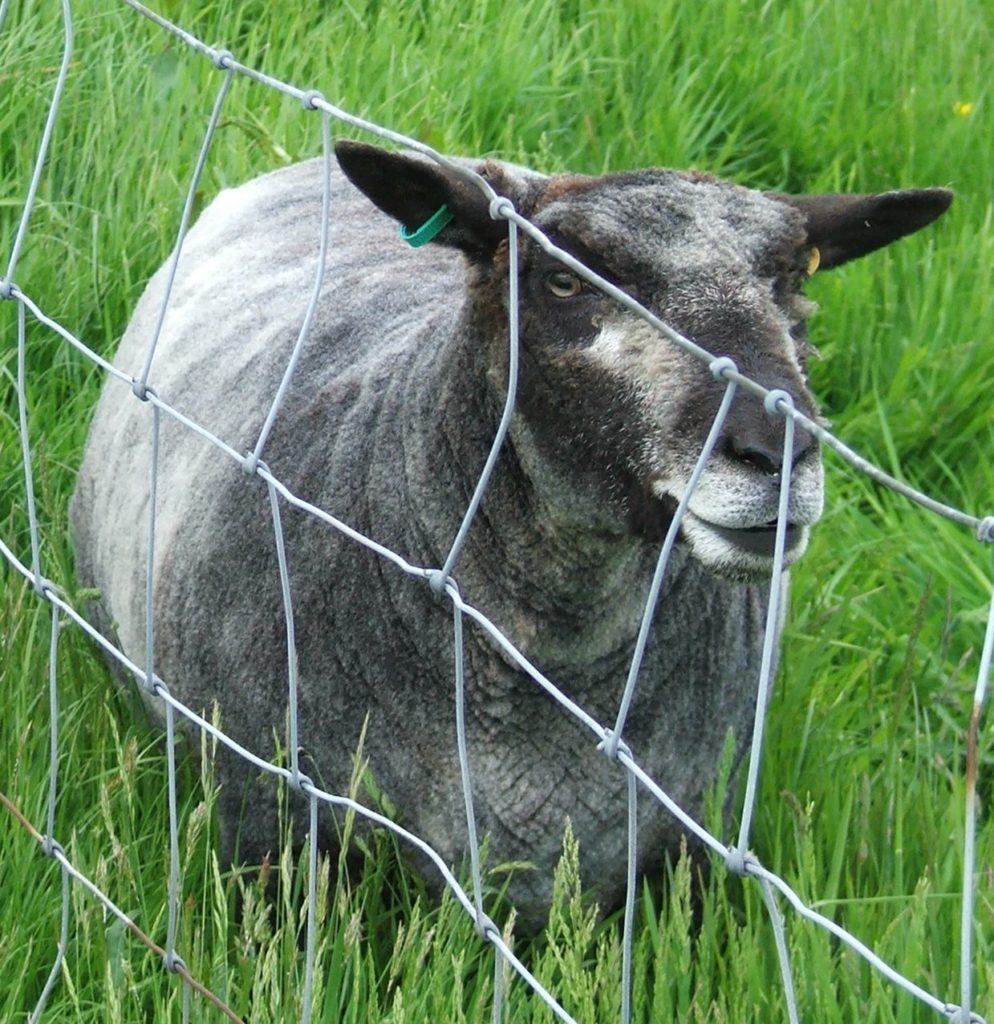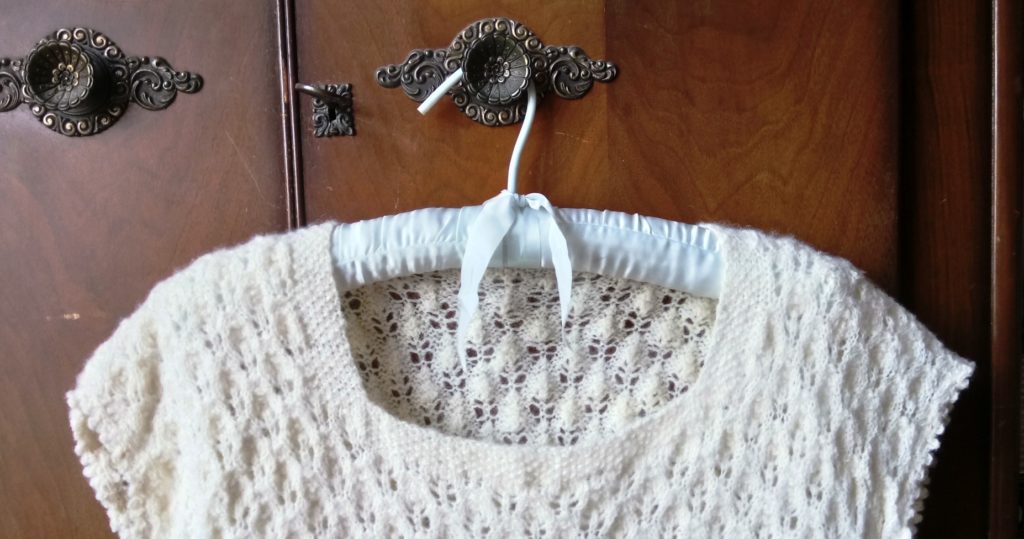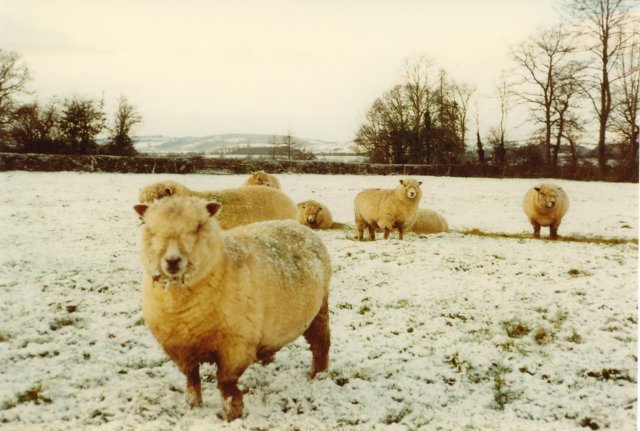As I drove up the track, I saw Helen. She waved at me from behind a full-sized skip bag of, what could be, the softest British wool – Ryeland wool. Fifteen Ryeland fleeces in a big sack. We exchanged talk about the journey over, then she said ‘I decided I might as well add in two Welsh Mountain fleeces from last year, if you want them’ as she looked over to the small Renault Clio I’d arrived in.
She explained how she rolls a fleece, with the wool from the neck area wrapped around the bundle to secure it. Into the car we pushed those bundles, squeezing them in, packing them up to the roof, and a couple on the passenger seat. We had to lean against them to shut the tailgate. Though this was a tight squeeze, I was determined. Seventeen fleeces were firmly wedged in.
I drove back from Wales with the window open, only because it was a warm sunny day. I thought they might stink, but they didn’t at all. They had a warm cosy smell – quite pleasant really.
This was fleece for spinning, a great big source of wool for practicing spinning, and I hoped in time, teaching. I never thought of it as a potential anti-dote to our destructive clothing footprint, our demand for soft, non-itchy clothing, and a contender for the title ‘softest British wool’. Though I rarely find wool itchy, many say they do, and it seems to be a barrier, for some, to wearing it. Hence, my attention on the soft wool.
Ecocide By Clothes
We pile acrylic knits along with cotton and synthetic fleeces into washing machines daily. Plastic microfibres gurgle down the drain from synthetic fibres, wash by wash – then we pull clothes out of the machine and sigh at the infernal bobbling and pilling. And just as bad: growing cotton has sucked the water out of inland seas because of our demand for cotton t-shirts.
So we feel guilt about all this – more and more now. We may be into fleeces from recycled fibres; organic and sustainable cotton. But what of the thousands of miles that we ship cotton round the globe? Have we thought about that? What if, instead of ‘sustainable’ cotton, we replaced more of our clothes with pure native wool? We could wear the fibre that we’ve clothed ourselves in for thousands of years, through fair weather or foul. And if we want the softest wool, maybe we should try Ryeland?
Softest British Wool: Iconic Sheep
I once had tickly, itchy jumpers, labelled as ‘lambswool’. I didn’t know what breed of sheep the wool came from, and I wouldn’t have thought to ask. Now wool can mean any mix of wool with acrylic and other fibres, so our concept of what wool is has become even more vague. Nevertheless, if I picked a jumper off the rail then, or some wool to knit with, there was a good chance it would have been pure wool.
Acrylic now reigns – times change. I wouldn’t have said that I was allergic to wool in those slightly tickly jumpers. Now I hear all the time ‘I’m allergic to wool’, or ‘wool is cruel’.
But wool isn’t just wool. Just like sheep aren’t just sheep, wool isn’t all the same, and neither are all sheep farmers. The British Isles, where I live, are home to diverse sheep breeds (nearly 60 breeds, 25 of them rare) and diverse flocks of sheep farmers and smallholders too.
From high mountain fells to lowland salt marshes or rocky island shore, our diversity in sheep reflects different terrain, micro-climate and generations of life lived with people. Some of our sheep are iconic – think Shetland and Herdwick. The same is most likely true of the country in which you live.
Merino Monoculture
We’ve made Merino wool the by-word for soft clothes which we like to wear next to the skin, if we don’t want synthetic fibres. Scarves, snug-fitting jumpers, cardigans and thermal underwear in Merino are more up-market and ‘eco’. But it isn’t the only soft wool suitable to wear next to the skin. We need not have a Merino Monoculture. Wool from short wool sheep, like Southdowns, Norfolks, Suffolks, Dorset, and my locals (Shropshire and Ryelands) are ideal.
Short, crimpy and soft, the fleece from which we spin Ryeland wool is light, and lofty. The sheep, from which we shear the fleece, are teddy bears of the sheep world: stocky, with a broad forehead and dense fleece.
Some say that Ryelands descend from Merino sheep, brought into the British Isles during Roman times. So Merino is probably in the mix, but they’re still distinctive and are a piece in the jigsaw puzzle of biodiverse flocks of sheep across the country.
Sheep In the Rye
Go west in Herefordshire to green, rolling hills of the English-Welsh borders, in the shadow of the Black Mountains and Brecon Beacons. Green pastures and fields of rye, shoulder high, lie in a broad sweep along the borderland. Here, a shepherd drives sheep from pasture to rye field, close to the farm.
Many hands have harvested the rye, and now the shepherd herds sheep into a field to graze on the stubble left behind. They are ‘folded’ on the stubble. The sheep feed and their dung enriches the poor loamy soils.
This is medieval England, and it’s the home of Ryeland sheep. North of Hereford, we find Leominster, the grange and the Priory. It is here that our shepherd, in a monk’s habit, herds sheep at dusk into a covered stall. He is one of many who shepherds these sheep and trades in that wool, at night, kept soft and protected from the worst of the elements.
Poor Soils; Fine Ryeland Wool
Rye grows better than wheat on the slightly acid, not very fertile loamy soils. Acid soils and lack of chalky grit here are a boon for the shepherd, for chalk has a soapy, corrosive affect on the fleece on the backs of their sheep. Sheep which have an easy life in warmer climates and fed on highly nutritious pasture will grow a coarse fleece. Yet here, pasture and rye fields are not the most fertile, and winters can be cold. Shepherds might protect their sheep from the worst of the weather at night, but, from what I understand, a little challenge (from cold and limited nutrients) is a good thing. The fleece grows soft and dense, keeping out the cold and wet. While on the western side of our country, carried on prevailing westerly winds, the rain comes down.
It’s all a matter of degree, and this, William Youatt, a vet writing in the 1700s knew well. He writes all this in Sheep: Their Breeds, Management and Diseases.
Power of Place
This is the power of place on sheep and their wool. Culture and people have played their part too, and as time goes by, our legacy of rare sheep breeds and diverse wool looms larger in my mind. It’s not, though, as if I could I walk down my local High Street and pick up a jumper or a warm winter coat made of Ryeland, Shropshire or Southdown wool.
Ryelands and other distinctive local breeds have dwindled since we’ve produced fibre, yarn, cloth, knitwear and clothes on an ever increasingly industrial scale over two hundred years or more. To be fair, since high medieval times, we’ve produced cloth on an assembly line. Spinners, weavers, dyers and clothiers working separately. It’s been production-line economics for a long time. But it pails into comparison with what happened when we shipped in cotton from the colonies, used slave labour in fields, and steam-driven mills.
Nature In the Rye
A flock of farmland birds descend upon patches of tiny weed seeds: corn chamomile, corn spurrey and poppy scattered on the ground after shattering of seed heads and capsules during harvest. Harvest mice, voles, and shrews from surrounding hedgerows follow on after the birds have gone.
While sheep drop dung all over the field, dung beetles and dung flies home in on their food. By night, bats flutter over the surface of the field, scooping up dung beetles in flight. Owls swoop down on small animals scurrying between rye stalks, picking on the seeds. The field is alive by night and day.
The rye fields may have all but disappeared, replaced by modern wheat, harvested by heavy combines. Few small mammals can survive heavy machinery, herbicides, pesticides and chemical fertilisers in those fields. But docile Ryelands are popular with smallholders and fanciers of rare breed sheep where these rye fields once were. And beyond. Despite modern life, in small paddocks and fields of family farms and smallholders, pockets of nature hang on alongside these sheep.
Where Can You Find Ryeland Wool?
You may wonder, where can I find wool from these distinctive, nature-accompanying sheep? You can buy clothes and blankets made from this wool. But if you want to make your own, you can spin from raw fleece or processed fleece, or simply buy the yarn.
I’ve never bought any clothes made with Ryeland wool. But nevertheless, it’s my go-to wool. Not just because I have so much of it, but because of its particular qualities and the way in which I came across it for the first time. From the heartland of this rare breed of sheep, I bought that enormous batch of white and coloured (grey) fleeces.
Through western Herefordshire I went, and just over the border into Wales, in the rolling, green hills around Knighton.
I was relatively new to spinning at the time, but able enough to offer to teach spinning on drop spindles to children at my local Young Archaeologists’ Club. As I was looking for fleeces for a couple of sessions teaching hand spinning, I decided to buy some fleeces for myself. I had no idea how much fleece I might get through. I saw on eBay that Helen, in Wales, was selling fleece from her flock of Ryelands, so I put in a bid and won the goods – fifteen fleeces. When I told my husband (he who grew up on a livestock farm), he said ‘What! You think you’ll get all that in the car?’ I had no idea. Off I went. When I arrived, and saw them though, I understood his concern.
Fine Qualities of Ryeland Wool
I washed and spun it (slowly) for some time, which is no surprise. But eventually I had to let some go. It occupied a skip bag in the garage, and as we needed the space, it found a use as mulch on our allotment, but I very much regret that fall-back option.
By now I have learnt something about it’s qualities and have much good to say about it. It really is very soft with not a hint of itchiness. It is a short staple fleece (short-fibred) and ideally needs to be carded into rolags and then woollen spun, so it takes some preparation.
Here’s one of the sheep that gave its fleece:

Lemster Ore
That monk at the Priory lets sheep out of the run, and back onto the rye field. On a warm September day, the doors to the barn are open; a light breeze wafts in, catching rye chaff and grain, as the Brothers toss it into the air from wide, flat wicker baskets. Grain and chaff separate. More sheaves are opened as threshing is going well.
Later, from the rye field, the shepherd walks up to the barn to speak to the others about managing the sheep for the rest of the year. Prices for Ryeland fleece are still high – like gold even; as at this time, it’s known as ‘Lemster Ore’. Their price is higher than Cotswold fleece, and we hear in a popular Flemish weavers song, ‘ In Europe the best wool is English, in England the best wool is Cotswold’.
It’s 1499 and Cotswold wool is going for nearly £15 a sack, but Ryeland wool fetches £25 a sack: taken from Sheep in the Cotswolds: the medieval wool trade by Derek Hurst.
This was before Queen Elizabeth I was apparently given some ‘Lemster’ wool stockings and thereafter insisted only on Lemster wool. I don’t know where that comes from, but perhaps this happened when she visited Worcester in 1575….’a little gift ma’am from the provinces’.
Dyed In the Wool
The grey-coloured fleece seems even softer than the white fleece – I don’t know why. The white wool also seems to take up dyes very well, giving some good solid, bold colours, but it probably isn’t the best for ‘dyeing in the wool’. It takes some work teasing out such short staple fleece once it has been through the dye pot, compared to Cotswold fleece. It makes much more sense to dye hanks of yarn.
Ryeland doesn’t felt easily, so if you knit with this yarn, or buy clothing made from the wool, it has a good chance of surviving the washing machine. Sure, one of the reasons why cotton trumped wool as a staple fibre is that is can take a lot of abuse. We can throw it in the washing machine, washing big loads at a time. We now have so many cotton or synthetic fibre clothes that most people don’t have enough wool clothing to wash a load on ‘wool cycle’.
It’s always the way, that one advance phases out the advantages the old once had – like non-felting fibres being suitable for a washing machine. Or even that wool doesn’t need washing as much. Yet, I still hand-wash some woollens, a couple of items at a time, spaced out over time. It doesn’t seem onerous to me.
Is Ryeland Wool the Answer ?
I wonder, is a marginal, niche wool of any use in the march towards less damaging ways of clothing ourselves? I suspect the dominance of cotton will be never ending, although we may veer more towards organic cotton, and care more about the way in which it’s produced. We’ve seen a backlash, lately, against fast fashion too. But our perception of ‘fast’ is relative. It looks like we’ve a long way to go from warp speed to slow.
British rare breed woollen yarn is getting more attention, but at the moment, Ryeland wool yarn is the preserve of die-hard spinners and knitters. You can, though, find clothes, such as shawls, and blankets handmade by artisan crafters or machine-made by small businesses producing on a more human scale too. So it’s out there, but not big business.
It goes without saying that there is no ‘one answer to rule them all’. Do we want wool, like Ryeland wool, to become big business anyway? How about many small businesses, using numerous rare breed wools? My inclination is to go for fibres with personality (and sheep with personality). Call it a little craftivism or activism – my own small stand for local distinctiveness, and against homogeneity and global corporates. That’s all we can do – go for what we want to do, and not worry whether that’s the mainstream ‘answer’ or not.

A Woollen Cycle of Life
When my longterm partner and I married a few years ago, I made my own pure wool bridal outfit, all British rare breed. That mountain of Ryeland wool played its part. I hand spun some of the wool and knitted it up into a vintage knit top, worn with a long-skirted suit made out of a cream Shetland tweed. Hebridean, Shetland and Manx Loaghtan wool made up that fabric by Ardalanish Mill from across Scotland. So I walked up the isle in Welsh and Scottish wool.
I’ve worn the jacket and the knitted top several times again. Eventually I might also shorten the skirt, to make it more usable (though it may pain me to do it). Who knows what will happen to my outfit in years to come. Maybe it’ll end up in a charity shop. But seeing as the whole outfit is biodegradable, it can rot in the ground. Then we can begin the cycle of life again, through a cradle to cradle cycle.
Seeing as the cycle of life can only run so fast to provide us with renewable fibres, and there’s only ever finite land to raise animals and crops, there’s surely only so many clothes we ought to have. Just like everything has to go somewhere, this is increasingly imprinted on my brain: everything has to come from somewhere. Let that somewhere matter.
Featured image courtesy of Richard Webb, creative commons license https://creativecommons.org/licenses/by-sa/2.0/deed.en

